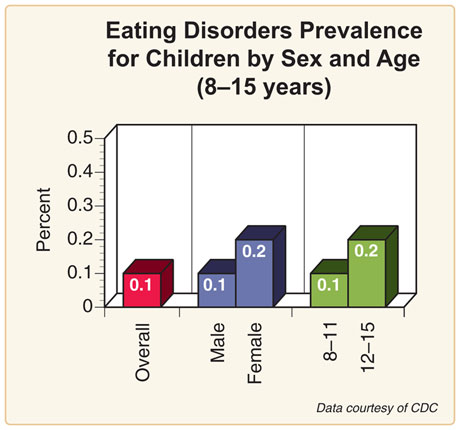
When body image impacts self-esteem
Body image effects people of all ages. But for adolescents—whose bodies are already undergoing massive changes—it’s especially critical.
Common disorders (and how to identify them)
Many body image disorders revolve around food and eating— but they also emerge through obsessive exercising and even in drug use. Here are ones to look for:
Anorexia
Attempting to be thin, adolescents use one or a combination of ways to restrict food intake. They may: • refuse to eat, move food around on plate • purge food from their bodies by vomiting • misuse diuretics and laxatives • use stimulants to suppress appetite LOOK FOR: weight loss, brittle hair & nails, dull skinBulimia
With this disorder, adolescents binge eat, followed by selfinduced regurgitation. LOOK FOR: long bathroom breaks, foul breath, stained teethBinge eating
Eating large amounts of food in small amounts of time LOOK FOR: (hard to spot because many binge in private)Body dysmorphic disorder
Obsessive-compulsive attention to a perceived bodily flaw. Here are examples:- acne fixation to the point of constant picking and cover ups
- exercising excessively or using steroids to bulk-up and gain muscle mass (mostly in males)
How to help
Though the disorders listed here are serious—and may require professional medical and psychological help—there are things you can do to both prevent and ameliorate body image conditions.
Move
One of the most beneficial things you can do is get them to participate in physical activity—either with you or with a group. The more they’re exposed to the benefits of a healthy body, the less they’ll fixate on what they look like to others.Media Bash
Have fun bashing unrealistic media portrayals together. Look for ads that are clearly airbrushed or movies that use stand-ins. Talk about how the media can brainwash our view of health.Mind over Matter
Discuss their interests, skills and talents. Help them see that who they are as a person is much greater than their appearance. And that the more they focus on what makes them happy, the less they’ll worry about body image.Remember
Fitness & Health
Help them reach realistic goals. If they simply want to lose a little weight by eating a healthier diet—or get stronger through a new exercise regime—be supportive. Understand the difference between a healthy desire to be healthier, and an obsessive disorder.
The Bigger Picture
Eating Disorders Among Children
 The Centers for Disease Control and Prevention’s National Health and Nutrition Examination Survey (NHANES) examines the prevalence of eating disorders among children who are slightly younger than those in the NCS-A. Data from the NHANES estimate the prevalence of eating disorders among 8 to 15 year olds to be very low; one tenth of one percent of this group.
The Centers for Disease Control and Prevention’s National Health and Nutrition Examination Survey (NHANES) examines the prevalence of eating disorders among children who are slightly younger than those in the NCS-A. Data from the NHANES estimate the prevalence of eating disorders among 8 to 15 year olds to be very low; one tenth of one percent of this group.


From The Blog
Social Media and Body Issues in Youth
Young adults who log onto social media sites frequently throughout the week or spend hours trawling various social feeds during the day may be at greater risk of eating and body image concerns, according to a new study.
Gender, specific age, race, and income did not influence the association—all demographic groups were equally affected.
